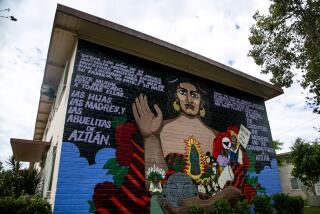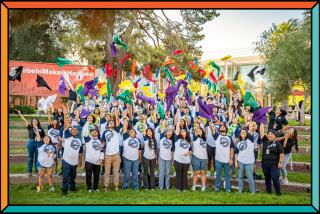Education Tops Chicano Group’s Political Agenda : Echoes of ‘60s Activism at La Raza Youth Conference
- Share via
For teachers Jorge Garcia and Ramiro Rosillo, veterans of the Chicano movement that flourished and then faded more than a decade ago, the daylong La Raza Youth Conference at Los Angeles Valley College last week was a hopeful but faint echo of a more promising time.
For the three Segura sisters, however, this was the genuine thing. This was grass-roots activism pushing society to the brink of change. Sara, 17, Esther, 16, and Judy, 15, all students at Pomona High School, were excited to be in the San Fernando Valley, where they met other Mexican-American students, heard speeches and took part in workshops.
“It’s very eye-opening,” said Sara, a senior who is considering a career in politics. “I learned about issues, like the one about names.”
The girls had just listened to several speakers say that Chicanos--people with roots in Aztlan, meaning Mexico and the U.S. Southwest--have been oppressed by whites and must preserve their identity. In a rousing conclusion, Veronica Arrequin, student body president of Valley College, urged her audience of junior and senior high school students to reject the labels “Hispanic” and “Latino.”
“Hispanic and Latino are words given to us by the Caucasians, by the Americans, to lump us together with all brown-skinned people,” said Arrequin, 20. “It is for their convenience. But we can choose our own name, and we choose to call ourselves Chicanos. Let’s hear it.”
The group followed her in a shout of “Chicano, Chicano, Chicano,” everyone punctuating the chant by jabbing a fist into the air.
“This is to build us up, to motivate us,” Judy Segura said later. “We’re not saying we’re better than anyone, only that we’re just as good. We’re not trying to gain domination. We’re trying to gain equality.”
Third Conference in 3 Years
Last week’s conference was the third put on at Valley College in as many years by La Raza Youth Committee, a small, loose-knit group made up mainly of San Fernando Valley teachers along with student members of MEChA chapters at Valley, California State University, Northridge and UCLA.
MEChA stands for Movimiento Estudiantil Chicano de Aztlan, the Chicano student movement of the Southwest. Organizers said about 530 junior and senior high students took part in this year’s conference.
“The goal is higher education,” said Arrequin. “We want these kids to finish high school first of all, and second, go to college.”
That task is not an easy one, according to Rosillo, 45, professor of counseling and guidance at Valley College. Rosillo, who joined the faculty in 1972, said gains made in Mexican-American enrollment have proved fleeting.
“The number of Chicano students at Valley has dropped from 5,000 when I came here to only 3,000 now,” he said. “Just as bad is the fact that Chicanos make up less than 1% of the faculty. And there are no Chicano administrators.”
Sam Mayo, assistant dean of admissions at Valley College, charged that Rosillo’s figures paint an unfairly low picture of the enrollment of Latino students at the school.
Drop in Enrollment
“You can say that the number of Spanish-surname students is down, but hell, there’s been a big drop in the entire enrollment,” he said. “The truth is that, in relation to the total picture, there has been an increase.”
Mayo’s figures show the enrollment of Spanish-surname students at Valley College rising steadily from 7.9% of the school’s total in 1972 to 16% in 1984, then staying at that level in the years since. Meanwhile, the number of students at the school has dropped from a high of about 24,000 in the 1970s to about 16,000 now. The statistics measure Spanish-surname enrollment and do not distinguish between Chicanos and other Latinos.
According to a U.S. Census estimate, 16.3% of the Valley’s population is of “Spanish or Hispanic” background.
At CSUN, officials said that persons identifying themselves as Hispanic made up 6.8% of the student body in 1979, the first year such figures were kept, compared to 8.2% in the fall of last year.
Garcia, 43, a professor of Chicano studies at CSUN who spoke on self-esteem at the youth conference, said afterward that the Chicano movement largely has fallen into a state of inertia.
“Part of it is because people are concerned about other things and about bettering themselves as individuals,” Garcia said. “But there’s almost a feeling that things did not get better like we expected them to.
“For a small number, it did get better. But there are more Chicanos today living in racial isolation than ever before. There are more living in poverty. There are more working for sub-minimum wage and more unemployed.
“There’s a large tendency to forget that group. There’s a strong sense among many that they’ve paid their dues and now they can enjoy what they’ve gained.”
Resurgence Seen
Nevertheless, Garcia sees the possibility of a resurgence in the Chicano movement.
“This conference was really heartening,” he said. “Students coming from as far away as San Bernardino and Pomona and responding to what they heard, it was very good.”
San Fernando Valley high school campuses sending delegations included San Fernando, Kennedy in Granada Hills, Van Nuys and Polytechnic in Sun Valley. Junior high school delegations came from Maclay and Pacoima in Pacoima and Van Nuys.
Students heard speeches in the morning and attended workshops in the afternoon. Workshop topics included drug and alcohol abuse, responsible decision making, self-esteem and social activism.
The conference was the second of its type attended by Teresa Alvarez, 17, a senior at San Fernando High.
“I went to one in Sacramento that lasted a whole week,” she said. “I really like them because they give a spiritual lift. They give self-pride and also leadership skills.”
CSUN’s Garcia charged that, to a considerable degree, white society still holds the view of Mexican-Americans presented by writer Francis Parkman in the 1849 book “The Oregon Trail.”
“He talks about ‘dark, swarthy, mustachioed faces gazing stupidly out from under broad-brimmed hats,”’ Garcia said. “Even from the media today we are getting constant negative images. We need to reject that and have some kind of positive say.”
Need for Pride
Laura Orozco, 22, a CSUN journalism student who covered the conference for the Valley College student newspaper, also touched on the need for pride among young Chicanos.
“I like to go to these events because conferences like this are what motivated me to go to college,” Orozco said. “I had good support at home, but these conferences helped a lot. Something these kids lack is self-esteem, and that holds them back.”
Jose Bedolla, 17, a senior at Pomona High, has been accepted to the University of California campuses at both Berkeley and Santa Cruz. He said he hopes to be a part of a renewed drive to educate Chicanos.
“Right now is a rejuvenation of the MEChA movement,” said Bedolla. “It’s a real Chicano movement to educate and better ourselves. I think it’s not enough just to educate yourself. You have to go back and educate others.”
If a recent study on the aging of America is correct, the white population may have a vested interest in seeing conditions improve for Chicanos. In December, researchers for the Carnegie Corp. warned of a shortfall in retirement and old-age benefits for whites in the next century unless there is a rise in the educational and economic level of the country’s Spanish-surname population.
This is because taxpayer-supported programs for the elderly will be financed increasingly by working Latinos, who now are among the lowest of income groups. The study noted that the nation’s Spanish-surname population is growing at three times the rate of the country overall, and that Latino families are more likely to have children than other groups.
Past Activism Recalled
Xenaro Ayala, a teacher at Pacoima Junior High who helped organize the conference, said that Chicano groups must adopt some of the aggressive activism of the late 1960s and early 1970s if they are to see more of their number continue beyond high school.
“We’re getting after college administrations to recruit more, like they did in the past,” he said.
Danny Alcala, 17, said attending the conference had made him want to start a MEChA chapter at his school, Kennedy High.
“We have a lot of Chicanos, and right now there’s nothing going on,” he said. “We’re not organized. But we want to show the rest of the school that we’re just as useful as they are.”
Alcala, who said he “used to be into street stuff,” referring to drugs and crime, wants to help teen-agers who may be prison-bound.
“I have a lot of friends who sell drugs, and if we can get them to do other kinds of jobs, they can get out of the drug life,” he said. “Right now they don’t know there’s other ways to be.”
More to Read
Sign up for Essential California
The most important California stories and recommendations in your inbox every morning.
You may occasionally receive promotional content from the Los Angeles Times.










